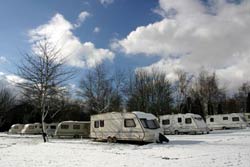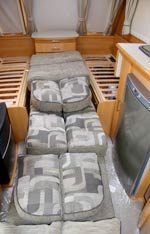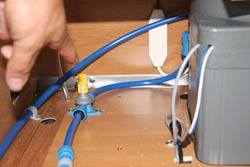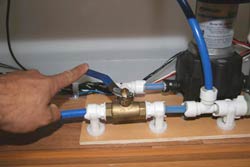It doesn’t matter whether your caravan is at home, on a site or in storage over the winter months, you must still ensure it’s properly prepared to protect it from the elements.
If you’re not planning to use your caravan over winter, taking some time now to carry out a series of measures will mean opening the door for the first time in the spring shouldn’t present you with any nasty surprises such as an invasion of rodents or a widespread damp problem.

Caravans in the snow
Before doing anything to prepare your caravan, it might be worth booking it in for its annual service during the winter as whoever will carry out the work is likely to be less busy.
Also, start making a list of in-caravan items you’ll want to bring home with you. These could include clothing, bedding, towelling, curtains and electrical items and keeping them at home will prevent them from getting damaged if a problem does arise.
Also, not having expensive items like your TV and DVD player on display in your unattended caravan will hopefully deter thieves from breaking in.

Stack upholstery in the middle of the floor
There are ways in which you can minimise the risk of condensation and dampness causing damage to your caravan and any belongings left behind.
Bowls of salt left dotted around the place will absorb dampness as will dehumidifying crystals, which are available from DIY shops. Stacking upholstery in the middle of the lounge area will also protect them from the damp.
Frozen water in pipes is also a potential danger so before leaving your ‘van for winter drain the system down by turning off the water system and opening all the taps.
Ensure the kitchen and bathroom are cleaned thoroughly with bicarbonate of soda or anti-bacterial liquid to prevent a build-up of mould.
Leave the fridge door open (and any cupboard or wardrobe door for that matter) to prevent them from smelling musty and attracting damp and check that fixed ventilation points are not obstructed.

Draining down the boiler
Drain the cassette toilet (the drain point is normally inside the external door) and use plugs to block the sink and keep the toilet lid closed to ensure any unwanted rodent visitors from gaining entry. If the toilet has been drained consider stuffing the u-bend with newspaper as an extra preventative measure.
It’s also worth oiling moving parts of the caravan, such as the handbrake and corner steady, to stop them from seizing and give the outside of the caravan a good clean to prolong its life.

Draining down the water tank
And if you are able to, it’s worth opening the caravan’s doors and windows occasionally to circulate air around the interior.
If you are in any doubt about what to do to protect your caravan from the elements over winter then it’s worth consulting your dealer to ask for their opinion.


Hi Sam,
we would say leave the leisure battery in but charge it up every now and again or leave it on trickle charge over winter, particularly if you’re frost prptection function relies on it.
Also 20*C seems very high, usually frost protection thermostats kick in when the temperature drops below around 4*C, simply to prevent pipes etc freezing.
regards
Neil
Caravan Guard
is it worth taking the liesure battery out as i have a frost protection thermostat fitted in my van which turns on a heater below 20 degrees celcius
We would recommend speaking to your motorhome manufacturer regarding the battery as each model will be slightly different.
With regards to not taxing the motorhome make sure you get a SORN (Statutory Off Road Notification), otherwise you can be fined for not having the vehicle taxed.
Neil
Caravan Guard
When the motorhome is parked outside the house over the winter is it best to remove the battries or to occasionally start the engine? the motorhome has no tax during this period.